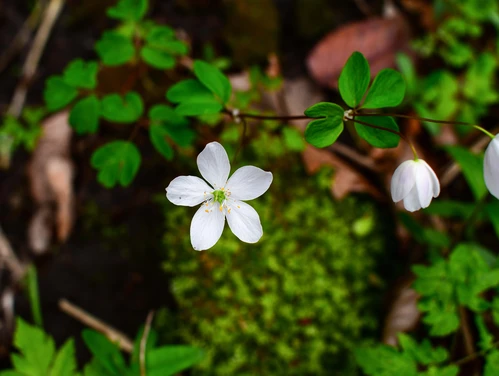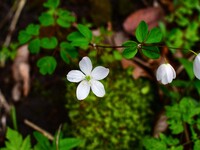On this page...
This is the last report of the season. Thanks for going wildflower exploring with us.
| Report Date | Area | Description of Woodland Wildflower Blooms |
|---|---|---|
| 5/19/2025 | Northern Iowa | Look for mayapples and nodding trillium in Floyd County.
Best parks to find woodland wildflowers in Buchanan County are Fontana, Jakway, Cortright, Wehner Woods, Grover, Boies Bend, and Anderson Addition. Look for Jack-in-the-pulpit, wild ginger, common blue violets, phlox, shooting star, false rue anemone, wild geranium, wild strawberry, starry false Solomon’s seal, Solomon’s seal, Solomon’s Plume, buttercup, mayapple, waterleaf, spiderwort, golden alexander, blue-eyed grass, yellow star grass, wild anise, yellow pimpernel, ragwort, bedstraw, wild rose, wild columbine, showy orchis, black raspberry and highbush cranberry shrubs and non-native dandelion, chickweed, lily of the valley, creeping Charlie, honeysuckle, dog cress and autumn olive. It’s the end of the season for blue cohash and wake robin. A large section of shooting star is still blooming in the central part of Bryantsburg Prairie. |
| 5/19/2025 | Central Iowa | Wild geranium, Virginia waterleaf, Jack-in-the-pulpit, columbine, blue phlox, Dame’s rocket, spiderwort, black locust, and sweet cicely are blooming at Springbrook State Park in Guthrie County. Wild raspberries are budding and will soon be blooming. Gooseberries have fruit forming.
Phlox (sweet William) and false Solomon seal are blooming at Easter Lake Park in Polk County.
Wild ginger, Jacob’s ladder, Jack-in-the-pulpit, wild columbine, and waterleaf are blooming at Buena Vista County Conservation Park. |
| 5/19/2025 | Southern Iowa | Phlox, Dame’s rocket, pussytoes, pale beardtongue, and blackberries are blooming in Appanoose County. Look for catmint and green dragon leaves. Mayapples, wild geranium, and Virginia waterleaf are blooming in Marion County. Some black cherry trees are still blooming. Dogwood shrubs are just starting to bloom. |
| 5/19/2025 | Western Iowa | Bellwort, wild ginger, columbine, Virginia waterleaf, Aunt Lucy, and Virginia Bluebells are blooming at Martin’s Access in Cherokee County.
Look for Virginia waterleaf, sweet William, lilac, garlic mustard, Jack-in-the-pulpit, buttercup, ground ivy blooms, sweet cicely, and honeysuckle at Moorehead Park in Ida County.
Virginia waterleaf, sweet Cicely, sweet William, Solomon’s seal, starry Solomon’s seal, and wild columbine at Stone State Park in Woodbury County.New bloomers in the northern Loess Hills prairies are large-flowered penstemon and New Jersey tea. Yucca is starting to “candle.” |
Keep It Clean, Keep It Fun for Everyone
Iowa DNR encourages all outdoor enthusiasts to pick up litter as they go with free reusable litter cleanup bags. The quick drying mesh bags fit easily in your kayak hatch, bike bag, picnic basket, tacklebox, car trunk or backpack.
You can pick up two litter bags at sites across Iowa. Find a pick-up site close to you. We recommend that you call first to make sure they are open and have bags available. New locations will be added to the map monthly, so keep checking back.
Back to topWhich wildflowers will you discover this week?
Wildflowers are enticing treasures for wilderness lovers each year. One of the most encouraging signs of spring, the first wildflowers seem to bloom overnight.
Early spring wildflowers are commonly called ephemerals, which means “short-lived.” They utilize a short time window when sunlight bathes the forest floor before tree leaves emerge to shade them out. It's a smart ecological adaptation and pretty, too.
Wildflowers can be found by simply walking, or biking along trails, on a hike through a local or Iowa state park or just driving slowly along a county road. It's illegal to pick wildflowers in public conservation areas, so take a photo or sketch your finds and leave the plants untouched.
Spotting secretive wildflowers is a refreshing, unique spring activity for the whole family. Get outside this spring and see what you can find. Please take only pictures and leave the flowers for others to enjoy!
Common Spring Wildflowers
Wildflowers come in countless varieties and yet can be so fleeting. They sprinkle wild landscapes with color and send subtle fragrances into the nearby air.
Look for these common Iowa spring wildflowers.
- Bloodroot
- Common blue violet
- Dutchman’s breeches
- Jack-in-the-pulpit
- Rue anemone
- Shooting star
- Snow trillium
- Speckled Phlox (wild sweet William)
- Spring beauty
- Virginia bluebells
- White trout lily
- Wild columbine
- Wild geranium
Bring Your Camera
Spring colors are popping up across Iowa. Here are easy wildflower photography tips:
- Avoid full, direct sunlight which can wash out colors. Early and late times of day yields dramatic side lighting.
- Overcast days are best with soft and even light that contrasts nicely against saturated or delicate wildflower colors.
- Moisture can help give photos interest. Shoot during light mist, or after a light rain. Droplets on leaves and flowers add interest.
- Get down low for better flower photos. People are used to standing eye-level views.
- For more dramatic photos, change the perspective and get down to flower level.
- Wear old clothes or bring something to lay on to get down on a knee or your belly to create more interesting images taken from a ground-perspective.
Resources
Ready to increase your wildflower activities and knowledge? These resources can help!
Wildflower Books & Guides
- Wildflowers of Iowa Woodlands by Sylvan Runkel and Alvin Bull
- Iowa Trees & Wildflowers: A Folding Pocket Guide to Familiar Plants by James Kavanagh
- Wildflowers of the Midwest: Your Way to Easily Identify Wildflowers by Stan Tekiela
- A Peterson Field Guide To Wildflowers: Northeastern and North-central North America by Margaret McKenny and Roger Tory Peterson
- Wildflowers of the Midwest: A Field Guide to Over 600 Wildflowers in the Region by Don Kurz
- Wildflowers of Southeastern Iowa -Volume 1 Spring by Don Weiss
Online Resources
- Celebrating Wildflowers - Just for Kids(U.S. Forest Service)
- Native Woodland Flowers for the Home Garden (ISU Extension)
- Iowa’s Spring Wildflowers (Iowa Association of Naturalists)
- Wildflowers of the United States Database
- Iowa Native Plant Society
- Native Plants Database (Iowa Living Roadway Trust Fund)
- Leave Wildlife Babies in the Wild
- Nature BINGO
Fun Family Outdoor Activities
- A Poem's Hunt
- Animal Signs Hike
- Birding Guide in Iowa
- Create Your Own Nature Journal
- Habitat Scavenger Hunt
- Look for Nature Hunt
Baby Wildlife - Leave them alone!
If you see wildlife babies on their own, let them be. Their parents know best, and most wildlife leave nests or dens well in advance of being able to care for themselves. Although broods or litters may become widely scattered during this fledgling period, they still remain under the direct care and feeding of their parents.
Not only is taking in wildlife illegal, it can often doom the creature you're trying to save. If you see injured, sick or wildlife in need, reach out to a licensed wildlife rehabilitator.
Back to topTick Safety & Protection
- More than a dozen tick species are found in Iowa, but three are most common: Blacklegged (deer tick), dog tick (wood tick), and the lone star tick. Ticks are active March through November in Iowa.
- Prevention is best. Protect yourself from ticks by:
- Wearing long-sleeve shirts and long pants tucked into socks
- Wearing light colored clothes, which makes finding ticks easier.
- Using repellent containing DEET
- Adding permethrin repellents on clothing per label
Checking for ticks while you're out and once you're home
How to Remove Ticks
- If you find yourself outdoors without tweezers and need to remove a tick:
- Use fine weight fishing line, thread or floss tied into a simple overhand knot.
- Gently tighten the knot around the head of the tick.
- Slowly pull the ends of the line to tighten the knot and pull out the tick.
- Always check your body and hair after spending time outdoors and remove ticks as soon as possible.

